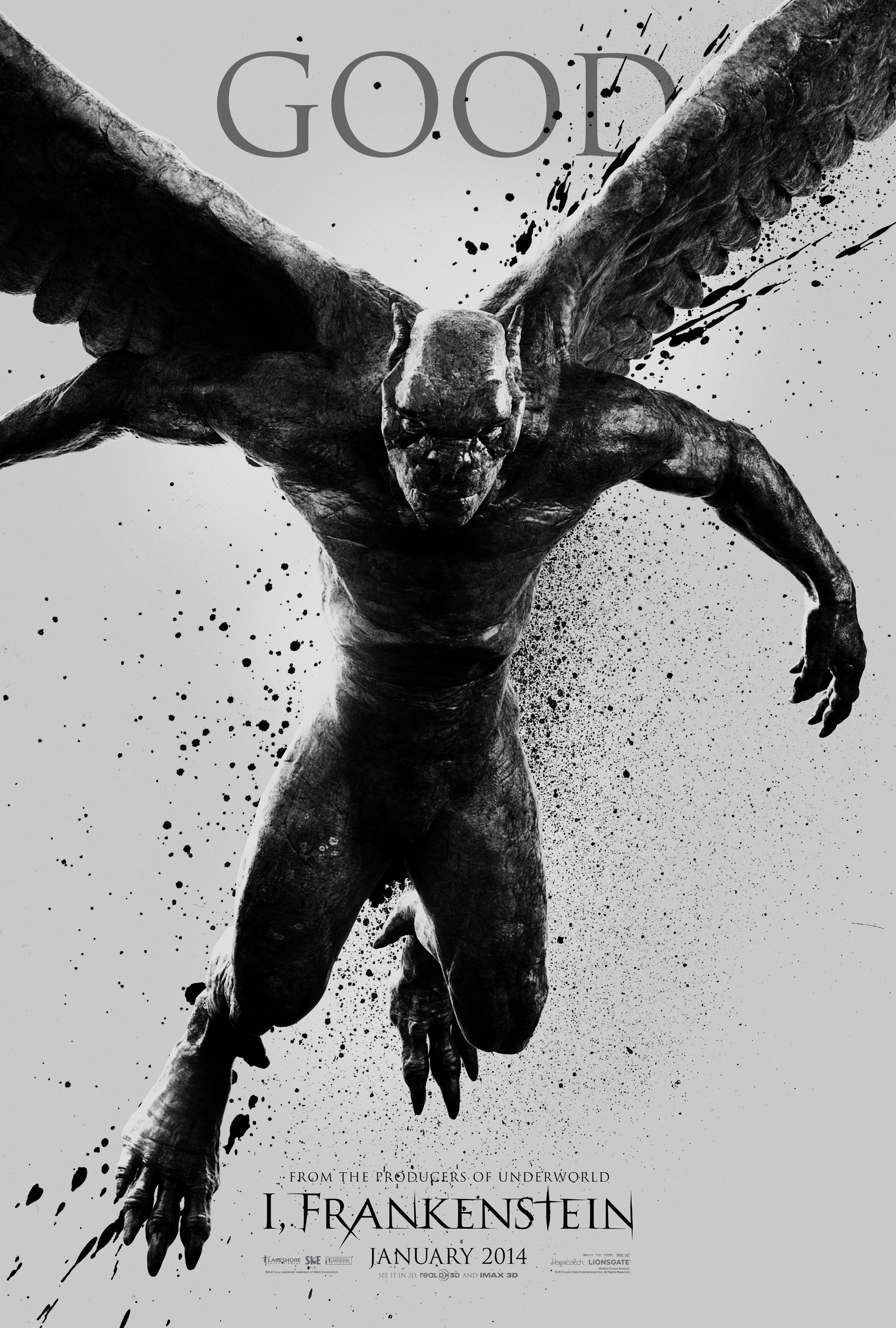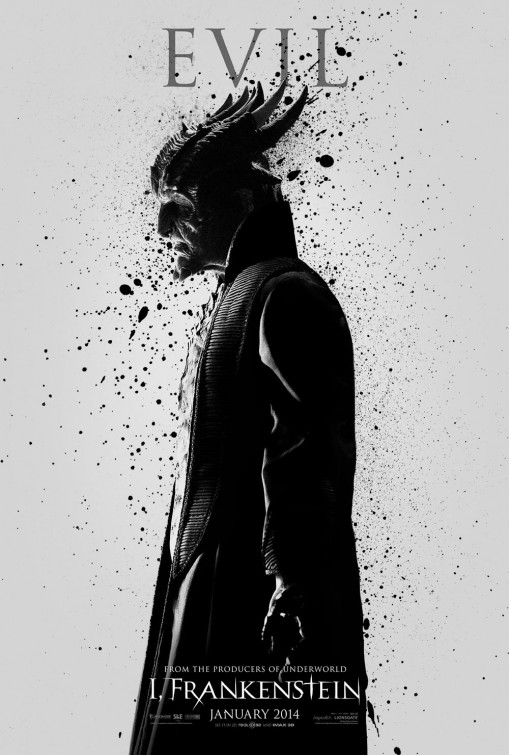Topic: "I, Frankenstein" review by Doc (lots of spoilers, as if anyone cares)
http://popcornculture1.wordpress.com/20 … nkenstein/
I struggled for a long, long time with how I wanted to open this review. The problem with writing a genuine, honest critique of a film like I, Frankenstein is that it’s too damn easy. I could do a serious exploration of all the movie’s faults, but this movie is so terrible that it doesn’t even deserve it. What did you expect? It’s I f**king Frankenstein, people. That is the title. I could put some effort into this review, but the movie sure as hell didn’t, and I’m not getting paid, so why even bother?
I’m reminded at this moment of my Elysium review, in which I similarly broke down the film beat-by-beat to uncover its flaws. But since I, Frankenstein doesn’t even pretend to be coherent, I question the efficacy of this method. Nothing I say will make the slightest bit of sense, so there’s little point in providing context. This is a confused movie, and I question whether anyone on set actually knew what was supposed to be going on. Half the time, even the actors appear not to fully understand what they’re saying. This goes double for Aaron Eckhart, who has to give the most ridiculous exposition and cannot sell it to save his life. He always sounds like an insane homeless man and not a grizzled action hero.
It really does feel like they just wrote a bunch of scenes out-of-order and tried to find some connecting tissue. At one point, Frankenstein (yes, that’s the creature’s name, we’ll get there) has a fight with a demon in an abandoned building. Why? Well, no reason. He’s just talking to his scientist love interest and then a demon kicks down the door and starts fighting him. There’s a lot of that in I, Frankenstein. Things happen because it seems like they probably should, and there’s no real attempt to have them make narrative sense. The bad guys apparently employ a creepy mad scientist, but he shows up in exactly two scenes and it’s never explained exactly what he does. He’s just sort of there.
If you’ve read the original Mary Shelley novel, you probably remember how it ends. Victor Frankenstein dies after telling his story to the captain of the ship which picked him up in the Arctic. His creature shows up to mourn over his body, and talks about how much it regrets the evil it committed. It tells the captain that it plans to burn itself alive, and the novel closes with the creature floating away into the darkness alone.
So obviously this is pretty open-ended, right? According to the producers of I, Frankenstein, it’s open to interpretation at least.
The film begins with the creature carrying his creator’s body out of the Arctic (no ship, no nothing) and to a graveyard where he scornfully buries him. We’re about 45 seconds in, and so far nothing is broken. But it’s in second #46 where the ball gets dropped. While filling in Frankenstein’s grave, the creature is attacked by two demons.
Yup. You read that right. Frankenstein’s monster is attacked by demons. From Hell. They want Frankenstein’s journal for reasons that aren’t immediately made clear. By which I mean that those reasons are never made clear, because this is a terrible, terrible movie. This journal is the film’s Macguffin, and it changes hands so many times that it’s easy to lose track of it. People talk about how important it is, and then other people say that maybe it’s not important, and then it totally is again, and I’m left staring into space thinking about the fact that I’m so privileged that I can afford to spend time and money seeing a movie that I know I won’t like. I’m the worst.
So, yeah. Journal, demons, whatever. Then two church gargoyles wake up, assume human form, and swoop down to kill the demons. The creature kills one, and they kill the other. Apparently when demons die, they turn into balls of fire and zoom into the ground. I hope you like that effect, because you’ll be seeing a lot of it. It really stands out against the muddy darkness that makes up the rest of the scenery. The demons were sent by someone named “Prince Naberius,” because this is that kind of movie. The gargoyles take the creature to their headquarters to meet the queen, played by Miranda Otto of Lord of the Rings fame (and I, Frankenstein infamy.) The queen is one of those rulers who seems totally incompetent at her job but stays in power because she has the “divine right to rule.” In this case, that’s literal, since the Gargoyle Order is fighting on the side of the Lord himself. Sorry, did it take you a while to get to this sentence because you were laughing so hard at the phrase “Gargoyle Order?” I don’t blame you. I just about lost it when they said it for the first time, and that was only five minutes into the movie.
Oh, by the way, a lot of people complained on social media that the film is called I, Frankenstein when it’s actually about Frankenstein’s Monster. Well don’t you worry, guys. The film isn’t that stupid! Miranda Otto (whose name is Leonore by the way) looks into the creature’s eyes and says, “Hey, you have the potential for a soul. You should have a name. Hmm…Adam. Your name is Adam now. Cool with that?” So now his name is Adam Frankenstein.
Adam. Frankenstein.
You know what the worst part of that is? It’s from the book. Seriously. Shelley writes the creature as a literate intellectual, and when he reads Milton’s Paradise Lost he connects with Adam. They were both the first intelligent beings created by someone, you get the idea. I think he actually mentions that he’d like to be called Adam. So apparently someone on the creative team did read the book. They just took a detail from it and sapped it of anything that’s actually interesting. Hollywood!
The Gargoyles would like Adam to stay with them, because he killed a demon in the graveyard and killing demons is super hard for humans. He declines, saying, “I go my own way.” Not at all like the creature from the book who longed for personal connection, but whatever. “I go my own way” is half of Aaron Eckhart’s dialogue, in one form or another. When he’s not reiterating that sentiment in the same gravely voice that just screams “I Can Do Batman Too You Guys,” he’s explaining the film’s plot to someone and doing a terrible job of selling it. Anyway, the Gargoyles give Adam some weapons to defend himself because he insists on leaving. It’s here that we learn that demons can only be killed by weapons inscribed with a certain symbol. The piece of wood that Adam killed the demon in the graveyard with was in the shape of that symbol.
This brings up an interesting question. Why don’t the gargoyles just carve that symbol into their fists or something? Like, if that’s all it takes, then I’d put most of my eggs in the “magic insta-death symbol” basket. They let Adam pick out his own weapons, and he takes two big sticks because he’s so blunt and big and he just wants to hit things. Then he spends 200 years alone in the wilderness. Occasionally demons will track him down and he’ll kill them with his Big Demon-Killing Sticks. After a while, he decides that he’s going to hunt demons instead of letting them hunt him. And finally, after an endless amount of setup and exposition, our story begins.
Adam walks into a nightclub (still narrating about something or other) and sees a demon. It’s not clear how he knows that this person is a demon, though apparently he’s been tracking the guy. It’s also not clear why a demon would have any interest in hanging out in a human nightclub. If you want to chill in a nest of debauchery and sin, the Internet has you covered. Adam chases the demon into an alley and has a fight. During the fight, the demon kills a policeman. This will be the last non-speaking human that we see in the film. After this, the streets of London are completely emptied out and every building is abandoned. By the way, I think it’s worth mentioning that Adam totally instigates this fight. The demon was just minding his own business, having a few drinks with friends, and then all of a sudden Adam Frankenstein saunters in like he’s High King of Big Stick Mountain and starts whacking the guy.
And then the gargoyles drag him in, all pissed because he let an innocent human get killed. “You cannot wage war in the streets!” shouts High Queen Leonore. Apparently she has ADD or something though, because not seconds later their HQ is attacked by the demons and she sends out her army to fight them. In the streets, of course. Oh but don’t worry. Like I said, London’s entire non-main-character population has been disposed of. Maybe they got Raptured or something. Who knows.
The demons attack, and there’s a very long and boring battle that there’s no reason to care about because…who are these people again? When the gargoyles get killed, they ascend in beams of heavenly light, as opposed to the orange descending flames of the demons. It’s good that they drew such a clear distinction, because I’ll be damned if I can tell the two sides apart half the time. I mean, look at these teaser posters.


I dunno about you, but both of these look pretty evil to me. They’ve both got the same scary-looking demon face, only one of them has more pronounced horns. The one that’s supposed to be “good” is doing a threatening pose and snarling, while the “evil” one looks fairly sedate. The movie itself doesn’t do much better in distinguishing them. This isn’t just a character design thing, either. It’s never established why the gargoyles are the good guys, other than that they stop the bad guys from doing bad things. What makes them good? What good things do they do? You can’t define someone based solely on what they aren’t or what they don’t do. And since they spend a whole lot of time being really awful to our ostensible protagonist, you have to wonder whether or not they were supposed to be sympathetic in the first place.
I don’t think I’ve brought up what the demon plan is yet. Well, to be fair, by this point the movie hasn’t either. To be even more fair, the plan changes constantly and makes absolutely no sense. There is zero consistency to the motivations of these characters. It literally changes scene-to-scene. The demon plan is so convoluted and strange that it could hardly be called a “plan” in the first place. Hold onto your hats, because this thing is a doozy. I’ll do my best to lay it out.
So, when demons get killed they go back to Hell in big orange balls of fire. This prevents them from ever coming back to Earth. Why? Who cares. Anyway, they can only come back if they possess a human, but they can only possess humans who are (a) alive and (b) without a soul.
This flies in the face of every bit of demon mythology in history, as I’m sure you’re aware. The whole point of demon possession is that they can take control of a living person who already has a soul. And since Adam is the first living creature to be created without a soul, how would they even know that possession is possible in the first place? It would have been impossible up to now.
Now, here’s the interesting thing. There’s a way to make I, Frankenstein a commentary on theology that’s both intelligent and in line with the themes of the book. The movie just barely brings it up early on, but abandons it for the “demon army” crap. Frankenstein’s monster is the first ever example that God’s power to create life is not unique to Him. There’s a pretty clear religious motif in the book that’s based off this idea, and the message essentially becomes, “Only God has the power to create, if humans try they’ll just fuck it all up.” What if the demons hunt Adam because they want proof that God isn’t any mightier than man? Surely that’s something that Satan could use to his advantage. If you’re going to do a movie that’s about angels fighting demons, how do you not make any sort of a theological point? Yet another example of how brain-meltingly stupid I, Frankenstein is.
What happens next in the film? Honestly, does it even matter? Nothing makes any sense whatsoever, and each scene seems to be part of a totally different story. The demons want Frankenstein’s journal. No, they only need the monster. Oh, wait, never mind, they need both. Except when they don’t. Seriously, you could take two scenes from different points in this movie and it would be impossible to explain how they connect. Random minor characters appear and disappear, like a mad scientist working for the demons who doesn’t actually do anything and appears to have no purpose since they’ve got Yvonne Strahovski working for them anyway. (By the way, her character’s name is Terra. Yup, spelled that way. Get it? BECAUSE SHE BRINGS ADAM DOWN TO EARTH AND SHE’S A HUMAN AND EARTH!!!!!!!!!1!!!1!) Characters have relationships off screen that we’re supposed to care about despite never seeing evidence of them. The two gargoyles who save Adam in the opening scene die in battle early on. The man dies first. Later on, Adam tries to save the woman, who is dying, but she says that she’s happy to go to heaven, because she and the man were forbidden to love each other while on Earth. Adam solemnly nods and lets her ascend. Keep in mind, not only did we barely know either of these people prior to this, but there was no indication of a loving relationship in any of their scenes. This literally comes out of nowhere, and it’s indicative of the entire screenplay’s attempt to create drama when the writers clearly don’t know how to tell a story.
I could go on describing every little stupid thing that happens in the entire movie, but you know what? I’m not going to. I’m stopping this train here. Everything that I’ve said so far (and keep in mind, I barely covered the first third of the film) applies to the rest of I, Frankenstein. If you’re reading this review because you seriously expected anything else, sorry to disappoint. There are movies so bad that they actually merit thoughtful discussion. You know, the kind of movie for which an exploration of its flaws is just as enlightening as a similar treatment of a really good movie. Those films have problems that need to be uncovered and can be fixed. I, Frankenstein is not that. In its wildest dreams, it wouldn’t be capable of imagining a movie as successful as that. There is not a human being alive on this planet who is dumb enough to genuinely believe that I, Frankenstein has any merit as a film. Well, besides being unintentionally hilarious. So is it even worth it to talk about what makes it bad? I think I’ve done more than my fair share of that.
I read something a week or so ago, something that made me think a lot about what I’m doing here. Someone on Twitter said that the best film critics open films up and reveal things inside them that you otherwise wouldn’t notice. That’s something I’ve been thinking about a lot. I think it’s a great way to approach criticism. But not for I, Frankenstein. Because this is a movie that is so self-evidently bad that no one needs it explained to them. If you’ve read this far, thank you for validating the precious minutes of my life that I spent watching this film. Because of you, my time wasn’t entirely wasted. From the bottom of my heart, I thank you. Together, we can rebuild. Together, we can move on. I leave you now with some wise words from an old friend. Words that help to restore the human spirit. Words that inspire greatness in all who hear them. Words that changed my life, leaving me stunned in my seat as the credits began to roll.
“We do not ask for the lives we are given, but each of us has a right to defend ours. I am fighting to defend mine. I, descender of the demon hoard. I, my father’s son. I, Frankenstein.”
–Adam Frankenstein










